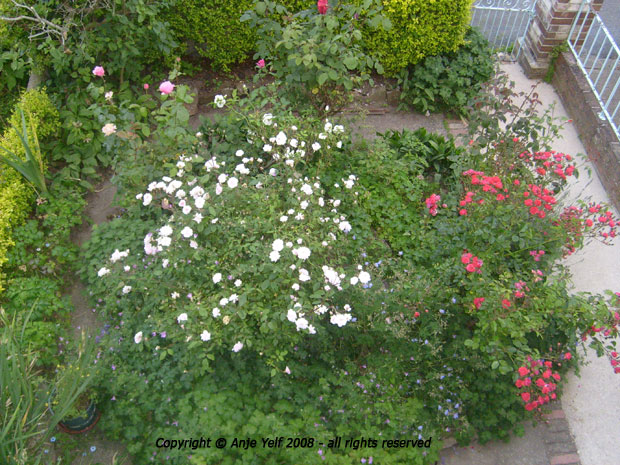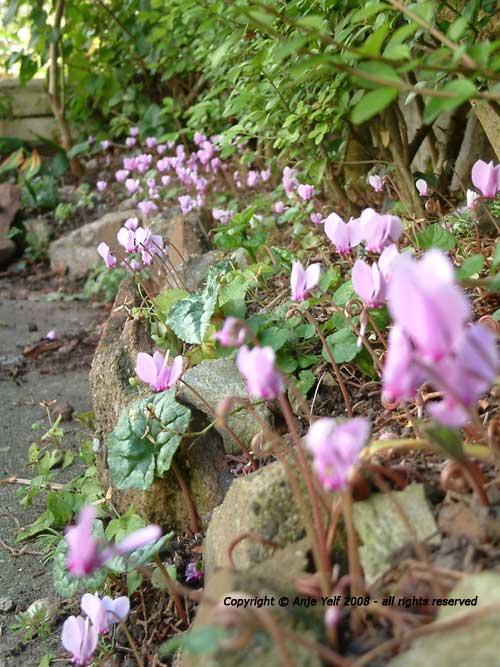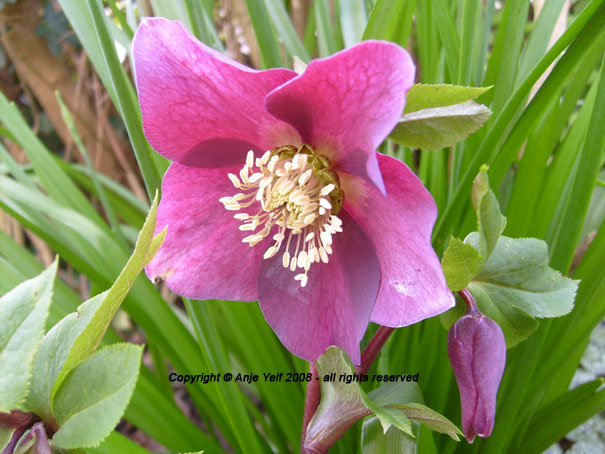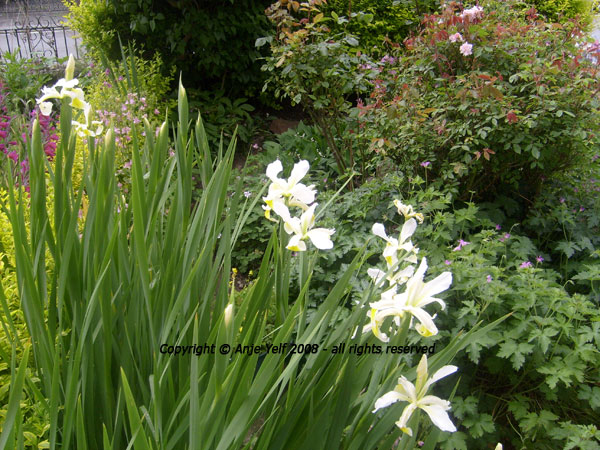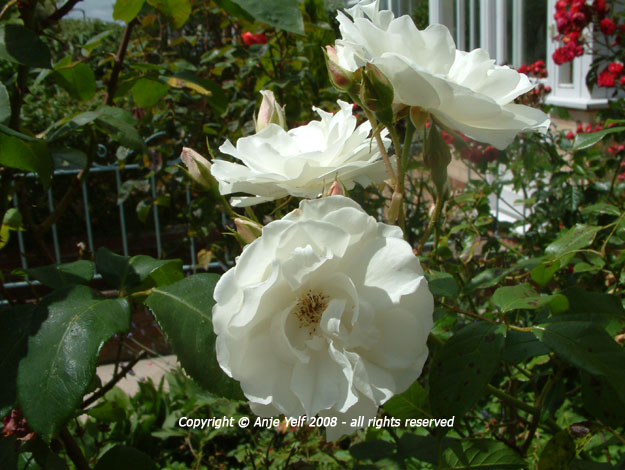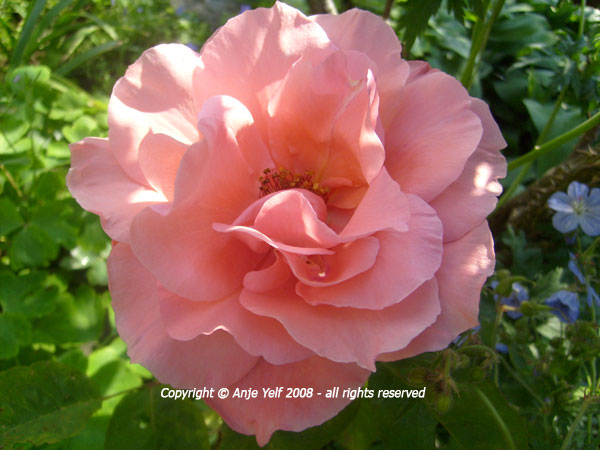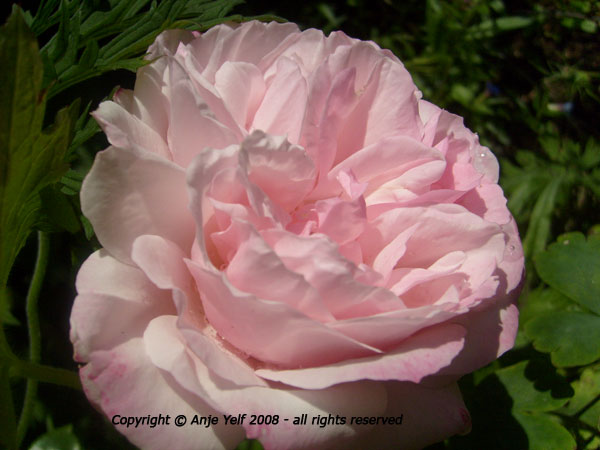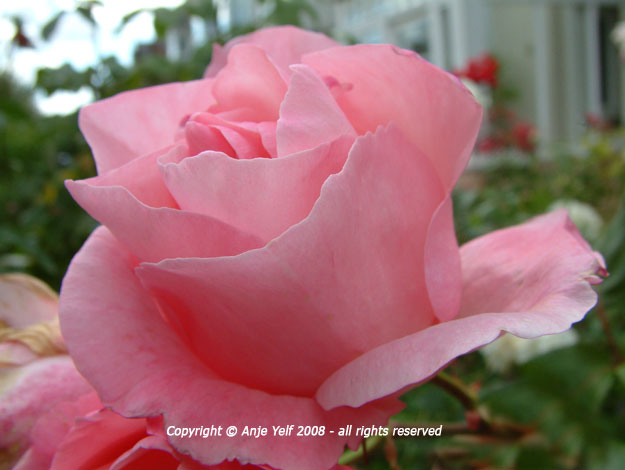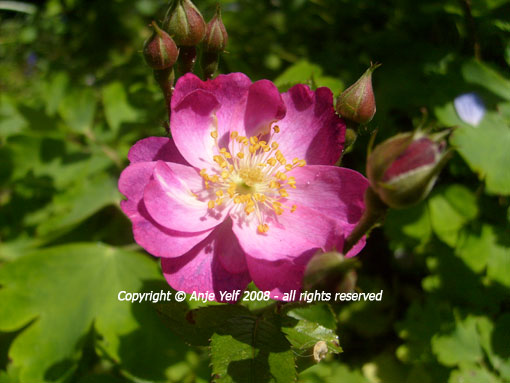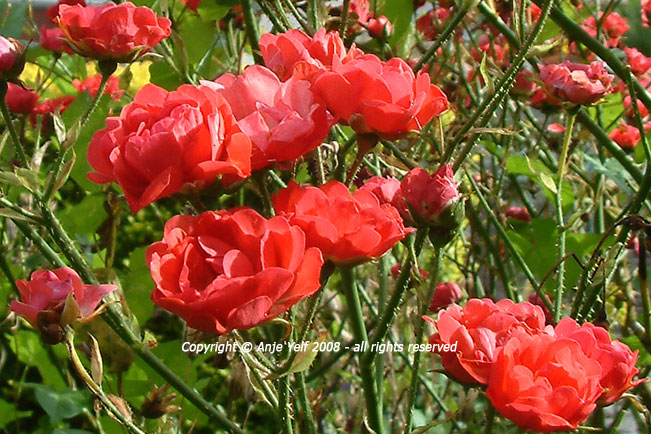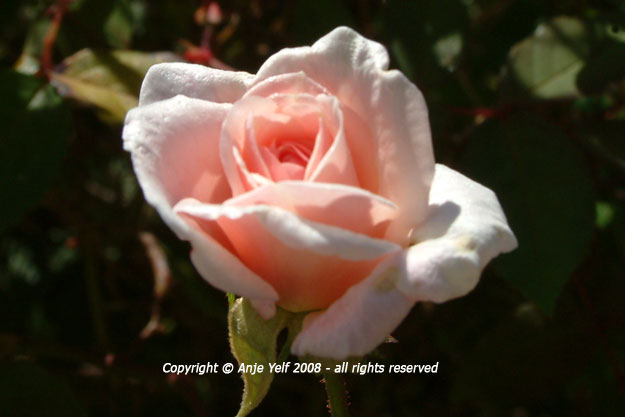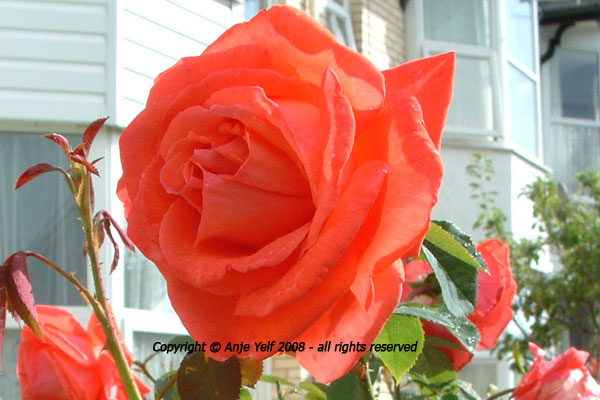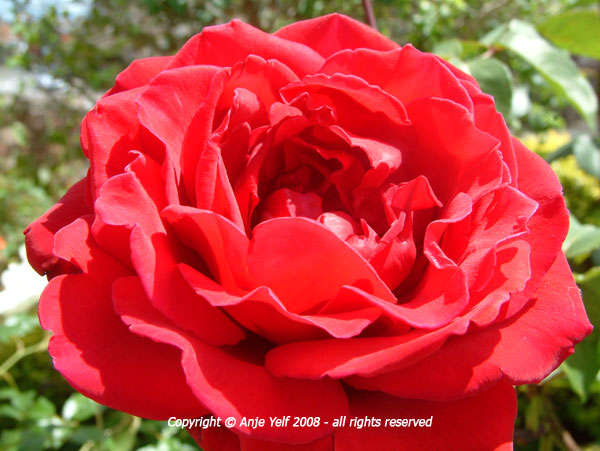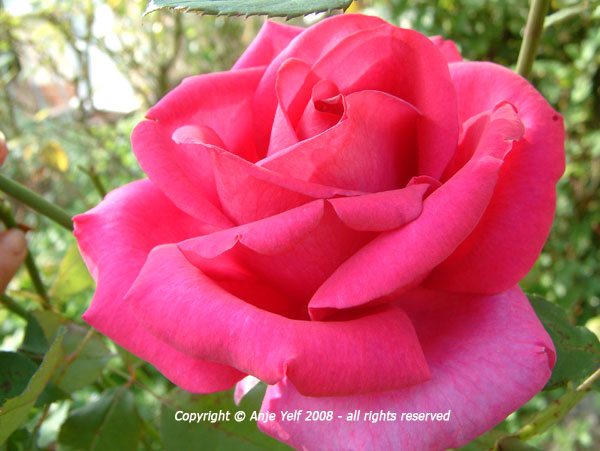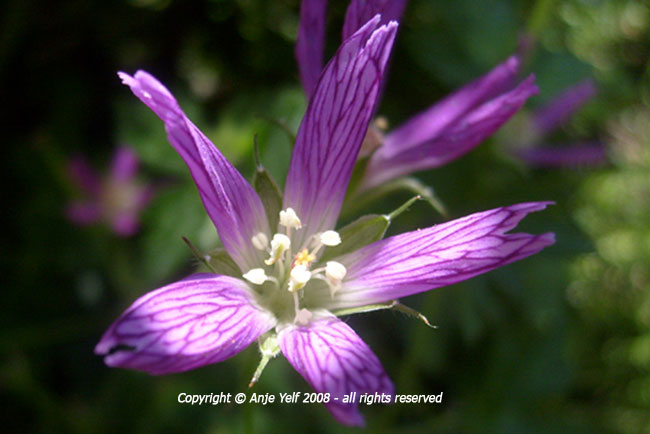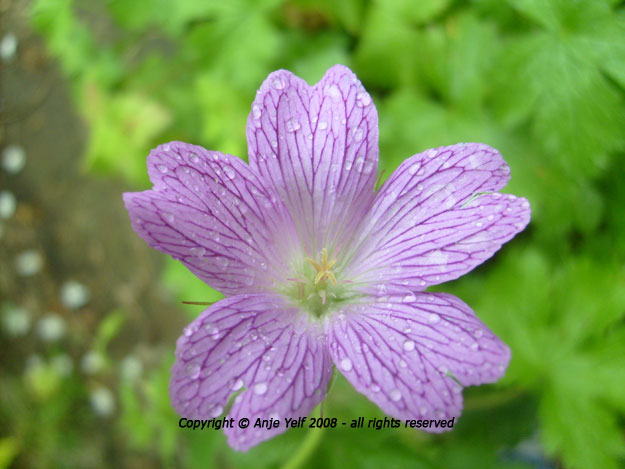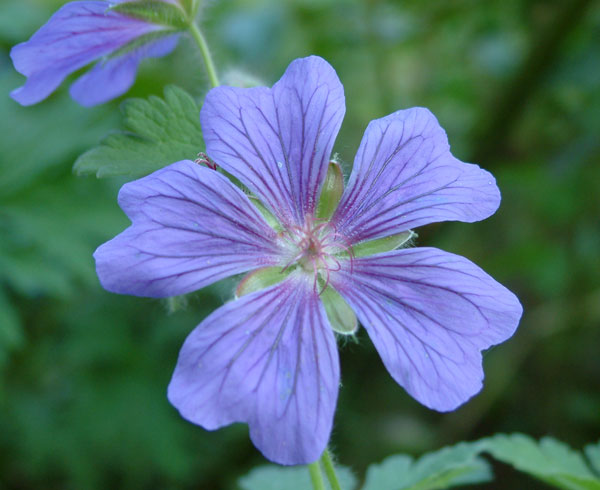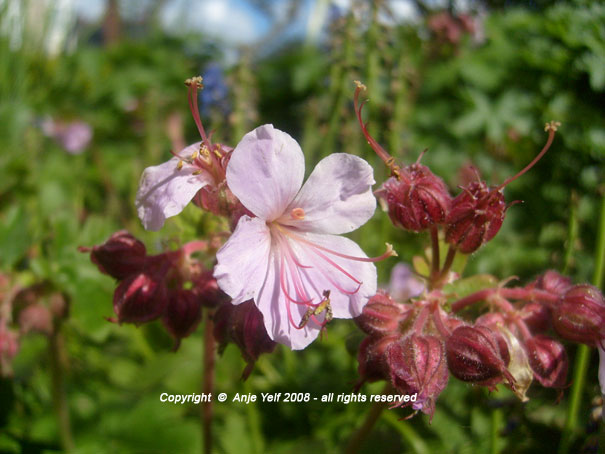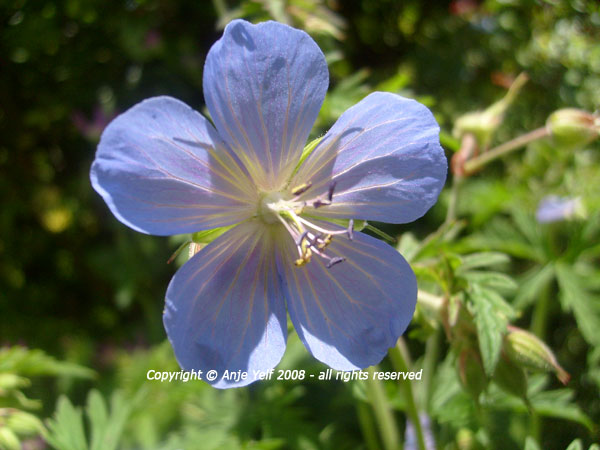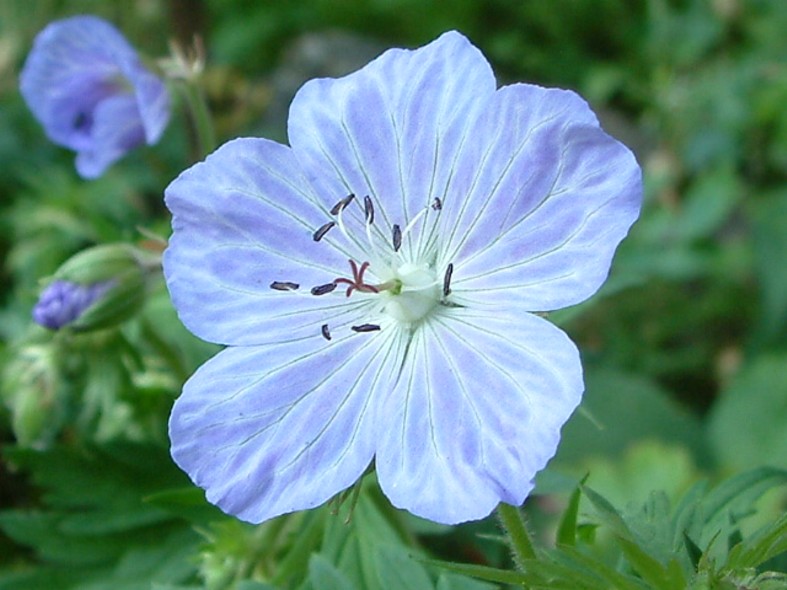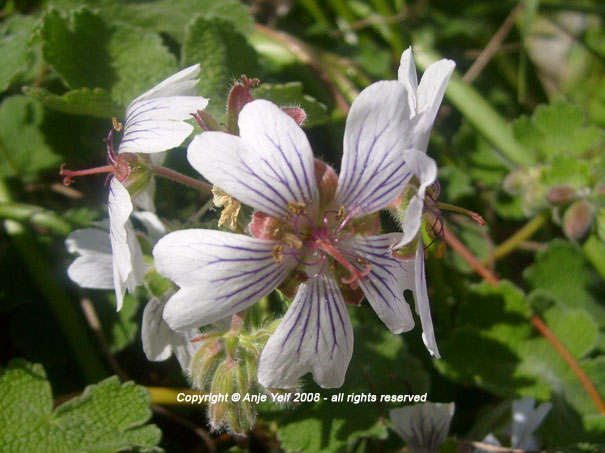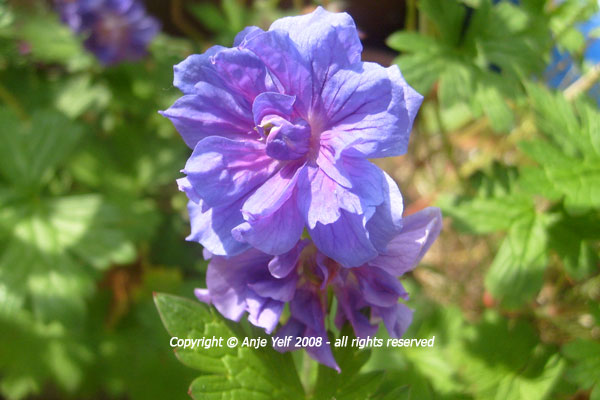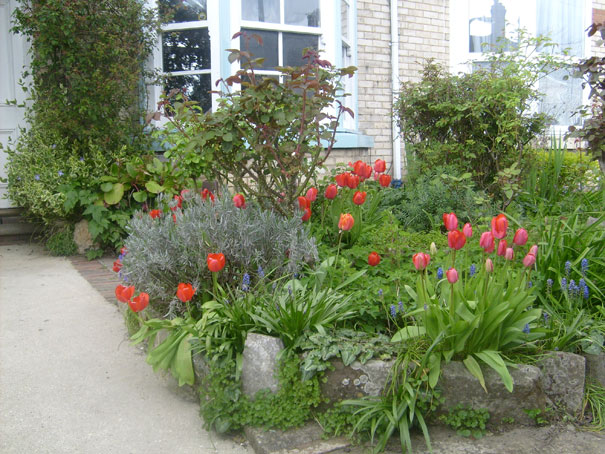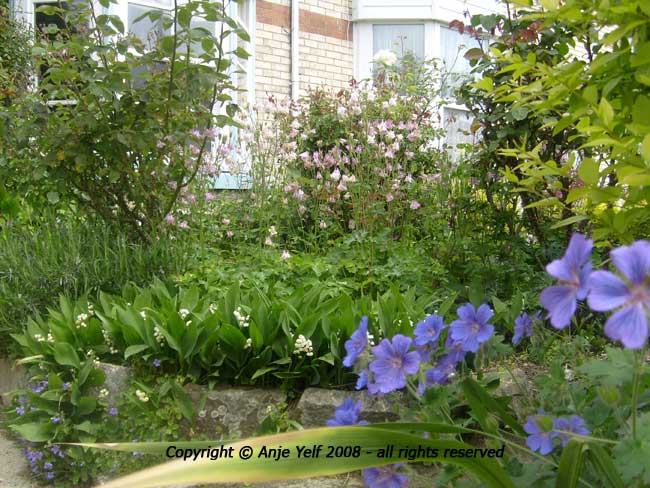My Edwardian Townhouse Front Garden
Hedge | Hedge Combination PlantsFragrant Flowers | Roses | Geraniums
Overall Design
The front south facing garden is about (18' x 20') with a straight path from gate to front door on the western side. This traditional and semi formal front garden has a golden privet hedge (Ligustrum Ovalifolium Aureum) along the eastern (new section now 12 years old replaced old dying hedge) and southern sides. As the garden has a full sun aspect all year, I have chosen to temper this by selecting blues, pinks and white as the general colour theme and the planting uses many traditional cottage garden perennials.
A circular rose and geranium garden forms the main focal point. The circle is further reinforced by a variety of scented red and pink roses with a white iceburg rose in the centre. An Albertine climbing rose arches over the front door; it is known that this rose was fully grown and flowering in 1967, so I'm not sure how old it really is.
The image on the left was taken in June.
The size and aspect of the front garden places constraints on the general size of planting, but I have a theory on how close flowers can be planted. I'm not too keen on weeding, although some is inevitably required, so I am a strong advocate for covering all the available garden so that most weeds just don't get the space. Most of the planting is done directly into the enriched soil, with moveable planters in front of the house windows and another hiding the gas meter.
Dotted around the center circle the Iberis (candytuft) produces a dark evergeen foliage and white flowers all year. This works well with the summer flowering Love in a Mist (Nigella) and both self seed.
The lavendar became too woody and outgrew the space, so it was removed. I missed the scent it produced, but I found a better replacement. Recently I planted Salvia 'Hot Lips' (Sage) in the circle facing the house. Fabulously aromatic leaves with elegant red and white flowers which are attractive to bees and the hummingbird hawk moth. It has a long flowering season.
The tubs below the window produce an end of year display of Nerine bowdenii 'Naked Ladies' with the centre tab containing Gladiolus peacock orchid which has delightfully fragrant flowers. Earlier in the year, I have primroses flowering.
The Hedge
The traditional English front garden would not be complete without a trimmed hedge. The Golden Privet hedge (Ligustrum Ovalifolium Aureum) has variegated yellow gold and green leaves and in June/July displays clusters of small fragrant white flowers. This particular plant enables gardeners to create a more formal traditional feel to their English front garden. Golden privet tolerates damp or dry conditions, shade or full sun aspect. It is attractive to a variety of insects, butterflies and moths and spiders, but it is harmful to humans if eaten. I trim the hedge twice per year in a simple box shape to keep a neat formal appearance.
Hedge Combination Plants
Two excellant combination plants for the shaded side of the Golden privet hedge are Cyclamen hederifolium (also called ivy-leaved cyclamen) and Helleborus.
The Cyclamen produces wonderful nodding pink flowers on elegant 6 inch stems from late August until October and variegated heart shaped leaves that are as much a delight and excellant ground cover throughtout the winter and spring.
The Helleborus orientalis was planted in the corner bordered on both sides by the Golden Privet. Clumps of Snowflake Leucojum, produce long slender leaves late in the year and flowers from December to February on long graceful stems. All parts of this plant are poisonous if eaten.
Along the eastern side (new section of hedge), the conditions change within only a few feet. This area of the garden is much drier and the border rather narrow. Tall, elegant dutch iris grow in the shelter of the hedge. The flowers appear towards the end of April. They attract many varieties of hover flies, bees and beetles.
Allium and Anchusa flower in the central area with the Iceberg rose and later in the year pink cyclamen.
Cyclamen |
Helleborus Orientalis |
Iris Hollandica |
Fragrant Flowers
I enjoy a garden that delights all the senses, so I've included plants that produce a scent. In addition to the roses and lily of the valley, I can recommend Salvia (Hot Lips) Sage. Brushing pass the over-hanging stems fills the air with a delightful aroma.
Plants for a scented garden
- Lavender's all year perfume; aromatic leaves; scented purple flowers during summer
- In January the sweet violets flower
- Muscari - Grape Hyacinth blooms in spring and gives a sweet soft scent
- Bluebells in spring produce an aromatic scent
- During May and June, Lily of the Valley fills the garden with perfume
- In June and July the Golden Privet hedge produces small fragrant white flowers
- From May until late autumn; the roses are a delight; each with its own particular scent
- From June to late autumn; the Salvia (Hot Lips) Sage foliage is delightful and refreshing.
- Cyclamen hederifolium displays in October, scented flower, but you need to get close
Roses
Maintenance
An English rose garden is low in maintenance. During the flowering season spray fortnightly with a systemic fungicide, for black spot, rust and mildew. Dead head the flowers and cut back to the next bud to encourage a long flowering season. Leave the aphids for the spiders, ladybirds and birds. Snails and slugs will be consumed by hedgehogs and toads, so do not use pellets. In the winter, cut back hard, but above buds. Remove dead, weak and spindly wood and cut back crossing branches that are rubbing. Loosely, fork over a layer of well rotted compost in the early spring as a feed.
Rose Garden Design
The main design theme comprises of nine roses forming a circle around a tenth rose. The eleventh rose is the climber 'Albertine', trained over a metal arch atttached to the wall over the front door. Some of the roses were inherited when we purchased the house, therefore I'm still trying to identify a couple of them.
The rose in the center is a floribunda Iceberg. A free flowering shrub that produces sprays of white blooms and lime green foliage on graceful almost thornless stems from early summer until early autumn.
I have found that this rose seems resistant to mildew and rust, but susceptible to black spot. Like all the roses in my garden, I have to spray with a systemic fungicide at two-week intervals to keep the blackspot in check.
Note: I do not spray anything to kill greenfly and other pests as I have found that if you leave well alone, the ladybirds, spiders, birds etc do the job.
Blessings |
Octavia Hill |
Queen Elizabeth |
Yesterday |
Unknown Floribunda |
Unknown Floribunda |
Fragrant Cloud |
Unknown Tea |
Buxom Beauty |
Geraniums
Maintenance
Some geraniums can be prolific and will soon outgrow the designated area. I dig up any extra plants that are surplus to requirements and either offer some to friends; sell at a car boot sale or turn into compost. Dead leaves can be removed in the spring, but otherwise these plants require very little maintenance.
Hardy Geraniums
A fabulous family of plants that survive in my clay soil and provide me with a very long season of colour are the cranesbill hardy geraniums. They attract a wonderful variety of wildlife into the garden, including bees, butterflies and other insects. They also survive well in dry conditions.
Armitagae |
Julie Brennan |
Phillipe Vapelle |
Ingwersen |
Johnsons Blue |
Mrs Kendall Clark |
Renardii |
Pratense Plenum Violaceum |


